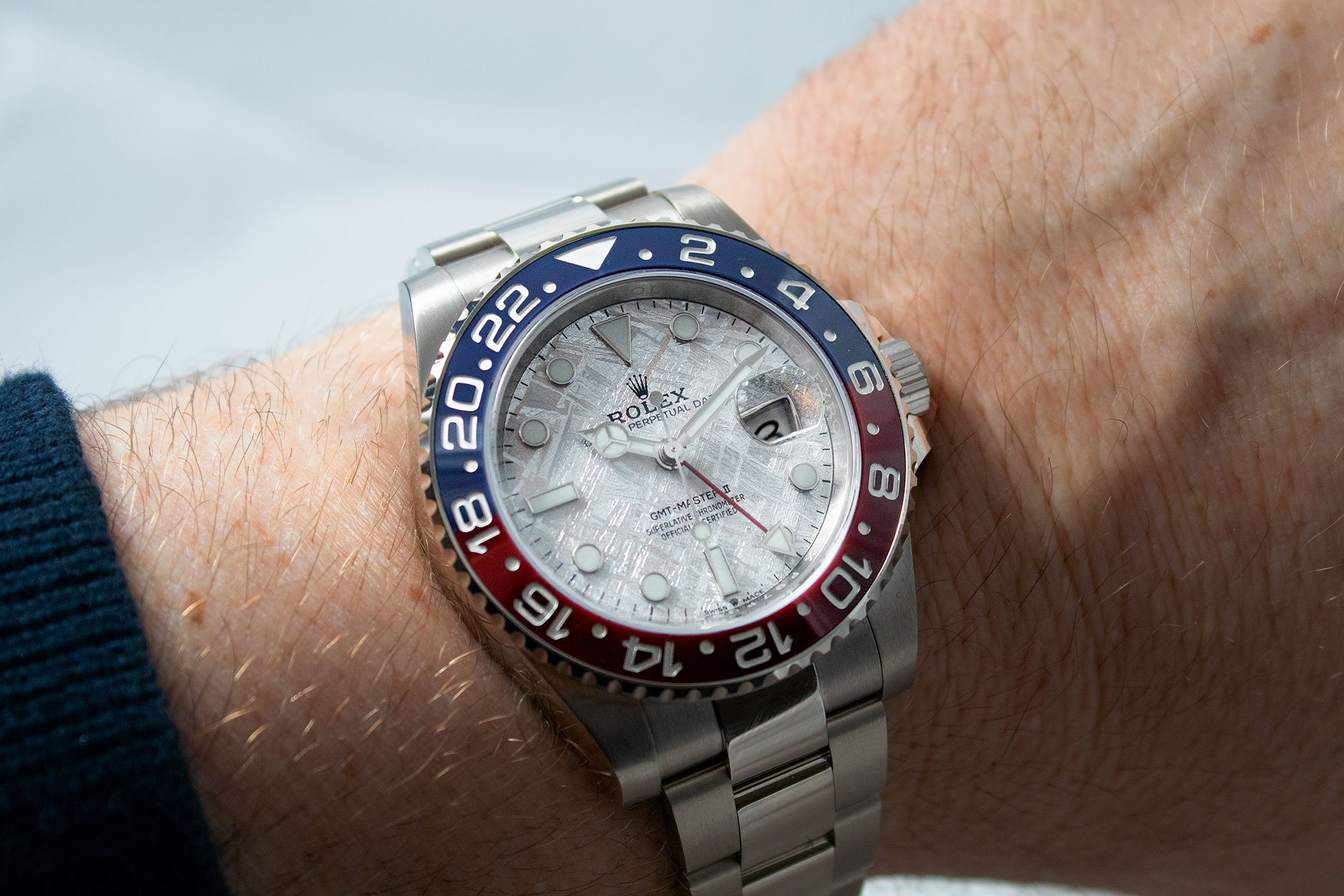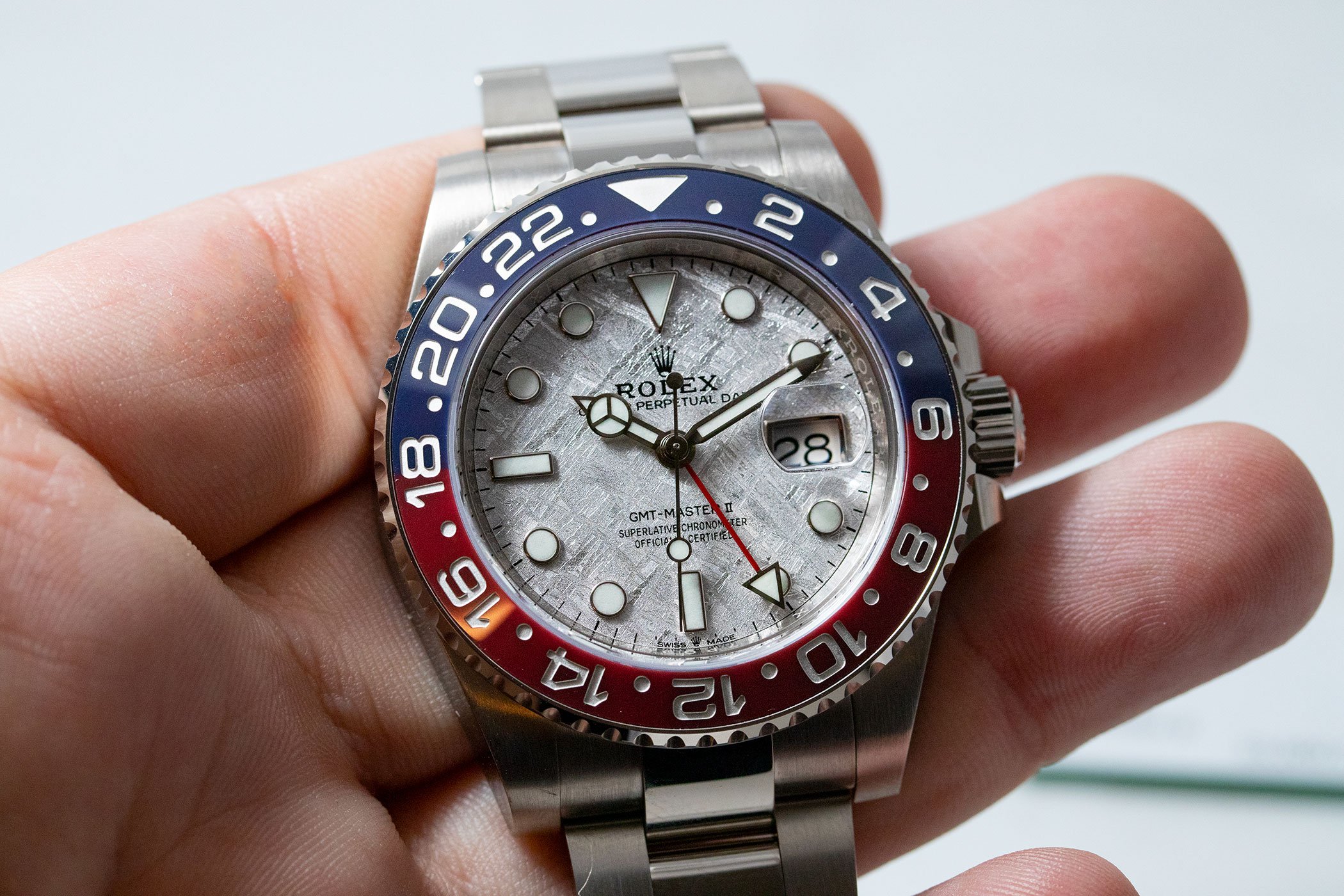Rolex GMT-Master II 126719BLRO White Gold / Pepsi / Meteorite
A rare addition to the GMT-Master II collection with a unique dial from outer space.

The Rolex GMT-Master II Meteorite 126719BLRO was presented at Baselworld 2019 as a “minor” launch, alongside the heavyweights of the show that included the Batman with a Jubilee bracelet. Funnily enough, this GMT-Master II Meteorite could be considered even more exclusive than the steel Pepsi or the Batman because of its original dial made from a slice of meteorite. It also marks the first time that meteorite appears on a GMT-Master II model… and you’ll see at the end of this article how this might be interpreted as an unexpected tribute to a legendary Rolex model!
If we were to remove the meteorite dial, this Rolex GMT-Master II Meteorite would be identical to the white gold Pepsi model we are all familiar with. It has a white gold case with a 40mm diameter and a white gold Oyster bracelet. The rotating bezel is inlaid with red and blue Cerachrom, a slightly duller colour than older models with aluminium bezels. The indices and hands are also made from white gold and treated with blue Chromalight. Since this 126719BLRO Meteorite is really about the dial, here’s a bit of background on the Gibeon Meteorite, the father of practically all meteorite dials on the market today.
Gibeon Meteorite
The Gibeon meteorite is a bit of a star in the world of meteorites and hurtled through the atmosphere and crashed on Earth in prehistoric times in what is today known as Namibia. First reported by Captain J. E. Alexander in 1836, the meteorite had been discovered by the Nama people and used to make tools and weapons. Classified as an iron meteorite, the meteorite shattered upon entry scattering more than 26,000 kilos of debris from outer space covering an area of 275km long x 100km wide. To date, roughly 25 tonnes of fragments have been recovered. As such, considering its size and weight, it has been used to create practically all meteorite dials on the market today.

The Gibeon meteorite probably originated as a piece of molten planet core and travelled through space for millions of years. During its space travels, the molten rock cooled down creating the unique patterns of crystallized iron and nickel that are technically known as “Widdmanstätten patterns” or “Thomson structures”.
Widdmanstätten patterns
In 1808, the Austrian scientist Count Alois von Beckh Widdmanstätten discovered that heating iron meteorites revealed a more intense colour and lustre and revealed the fascinating metal crystal patterns created by the iron and nickel. Since Widdmanstätten didn’t publish his findings, the discovery of the metal crystal pattern is generally attributed to English mineralogist William Thomson who in 1804, poured nitric acid on a slice of meteorite to remove the patina caused by oxidation and noticed how strange crisscrossing patterns appeared on the surface.
Meteorite has been used for decades in jewellery but wasn’t used by Rolex until 2008 when it launched a limited-edition white gold Rolex Daytona with a meteorite dial. Since then, it has been used in a couple of models, but given Rolex’ highly industrialized manufacture, a meteorite dial requires different handling. Given that the pattern of every sliver of meteorite is different, no two dials will ever be alike, a bonus for those on the hunt for something truly unique. Like Thomson, Rolex treats the meteorite slices to an acid wash to reveal the natural crystalline pattern.
Calibre 3285
Protected by no fewer than 10 patents, the movement powering this watch is the recently presented calibre 3285, which now equips all models in the GMT-Master II collection. Equipped with all Rolex’ in-house goodies, the movement features a Chronergy escapement, a Parachrom hairspring and delivers a robust power reserve of 70 hours. Like all Perpetual movements made by Rolex, the 3285 has a Superlative-Chronometer certification – COSC and internal certifications, resulting in -2/+2 sec. per day accuracy.
Availability and Price
The Rolex GMT-Master II Meteorite 126719BLRO retails for EUR 35,150, just EUR 1,550 more expensive than the normal white gold Pepsi – which now comes with a blue dial.
This doesn’t seem an excessive markup for a dial that has literally been made from a slice of historic meteorite. Originally designed in 1955 for professional navigators (Pan Am pilots) showing the time in two different time zones at a glance, this new meteorite version would be a fitting companion for a spin in outer space onboard one of Elon Musk’s SpaceX rockets. Naturally, obtaining this watch does not depend on money alone but on other factors that we already know about making it perhaps even more unattainable and desirable.


What makes it even more appealing is the fact that the 126719BLRO Meteorite is the only GMT-Master II model in collection with a light dial, the usual choices are between a black dial or dark blue dial… And now, if you think about it, if you combine a Pepsi bezel with a light dial, you’ll get something that could evoke the mythical “Albino” Rolex GMT-Master Reference 6542… And that results in a very cool watch indeed.
More information at rolex.com.








3 responses
Dare I say this is not pretty… at all? That’s to put it mildly.
The dial itself is interesting but there is not enough contrast between the hands and different elements of the dial. The old lume on the “albino” makes it much more readable. For that amount of money it would be nice if you could easily tell the time with it.
I’d want to know which planet the meteorite was from.